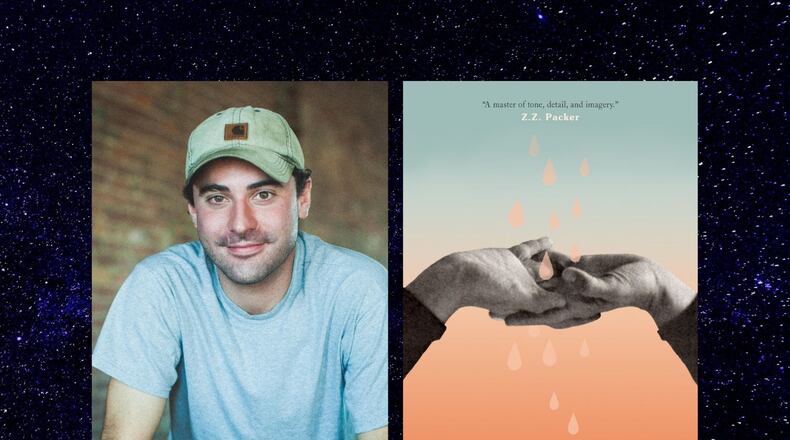In “Anecdote of the Jar,” poet Wallace Stevens places a jar in Tennessee and “The wilderness rose up to it.” In Andrew Siegrist’s story collection, “We Imagined It Was Rain,” water is the defining “jar.” The driving rain, flooded rivers and murky lakes set the tone for these tales of love and loss that capture a wooded, watery Tennessee.
Fathers in particular and their missed opportunities for connection with their children are chronicled with specific tenderness. In the opening story “Whittled Bone,” Russell obsessively tries to recreate his missing daughter’s dreams, salvaged from a journal found taped under a dresser.
Highlighting the fraught, naturally creepy images of an aged farmhouse (spider webs, eerily silent bedrooms after a summer storm, a decrepit grain silo, dead wasps), he painstakingly channels his grief into a macabre jar collection stored in a neighbor’s barn. As the power of ritual mixes with hope, he’s led to the edge of sanity, wrestling with losing a daughter and later, as a result, a wife.
Another parent/child loss figures in “Shinebone,” a poignant story about a father mourning a son. Like Russell, Shinebone engages in a senseless ritual as part of his struggles with grief, paying a neighboring boy to climb an enormous oak and light candles in the hopes God will perform a miracle and save his son. Sadly, drugs and alcohol take his son Clint at an early age, and the father has to maintain his sobriety while reckoning with his own past of substance abuse.
The father knows the danger, but is also powerless to stop it. When Clint shakes a pill container, jokingly calling it “Grundy County mating call,” Shinebone cannot see the humor: “That bottle sounded more like a rattler to Shinebone. A mean snake with a mouthful of poison, quick to strike at anything that moved past it.”
Somehow Shinebone manages to carry on. True to the water theme, Siegrist depicts sadness in everyday objects like the water mark in an old cooler that once held the father’s and son’s cigarette butts. Water is also the cleansing substance that fills a former liquor jar under Shinebone’s sink, offering redemption and hope: “For the first time in his life he was living in a dry house ... when he felt the thirst tightening his fist, he’d fill the jar with storm water and drink.”
In another emotional story, “Satellites,” a terminally ill father seeks his adult children’s cooperation in his suicide. A lifelong NASA buff, he plans to kill himself at the same time a satellite falls from the sky. Having already lost their mother, the brother and sister are distressed but want to respect their father’s wishes. The author’s use of detail packs an emotional wallop — in this instance something as seemingly trivial as a Space Camp sticker from a long-ago family trip stuck on the corner of a bathroom mirror:
“Half the sticker had been ripped off the night their father explained how one astronaut was always left behind. The others leave the shuttle to walk across the moon while one man stays in orbit. And at some point, when the shuttle is high above the far side of the moon, that man is farther from another human than anyone has been in the history of the world. Chelsea cried at this and tried to rip the Space Camp sticker from the mirror. Later, when she’d fallen asleep, their father glued it back. Ever since, you could see the rip where it has once been torn.”
Water can conceal things too, and Siegrist uses the real submerged towns of Tennessee to symbolize the double-edged “progress” that overtook rural life in the 20th century. When the Tennessee Valley Authority built the dams that brought electricity and helped curb flooding in the 1930s, more than one town was covered in new, man-made lakes and reservoirs.
In “Beneath Dark Water,” a young couple reaching a crux in their relationship float on the river, engine sputtering out, as Darcy tells Rae about when he was a child and would drop a magnet on a line in the water to retrieve artifacts from the drowned homes. As the couple argue, the expectant mother floats away from Darcy in hopes of seeing the stars — although the reader is far from assured of her safety.
In “Dryland” a 9-year-old girl listens to cassette taped interviews with people who lost their homes because of the dams. While staying at her grandfather’s, the things she experiences — the Braves playing in the 1995 World Series, her grandfather’s framed collection of feathers, a salvaged leaf-shaped pendant — take on an amber-hued reflection that’s more wise than sentimental.
Another real-life Tennessee historical event — the 1916 hanging of Mary the circus elephant — is the focus of several stories. After she killed a trainer by stepping on his head in neighboring Kingsport, the animal was brought to Erwin because the railroad had a crane large enough to hang her when shooting her did not accomplish the job.
In “How to Hang a Circus Elephant,” Siegrist writes in first-person narration as the train station agent tells of his role in the hanging with after-the-fact dismay. In “Elephants,” two boys see a photograph of the hanging during classroom presentations and visit the cemented ground where Mary is buried.
These are memorable stories. Images like a pastor draping soggy hymnals over tombstones to dry after a flood in “Shouting Down the Preacher” will stay with the reader a long time. The best of this collection leave the legends behind and capture the challenges of human beings with the rawness of a cold, driving rain.
FICTION
by Andrew Siegrist
Hub City Press
191 pages, $16.95
About the Author
The Latest
Featured

